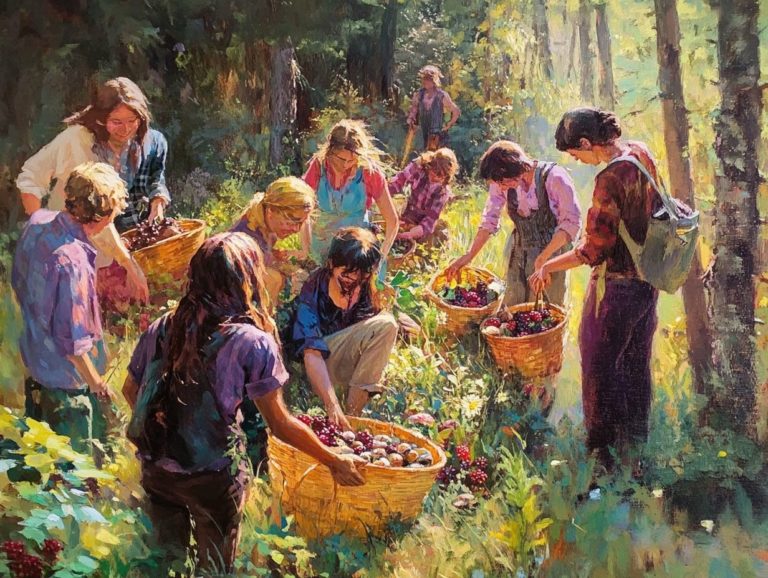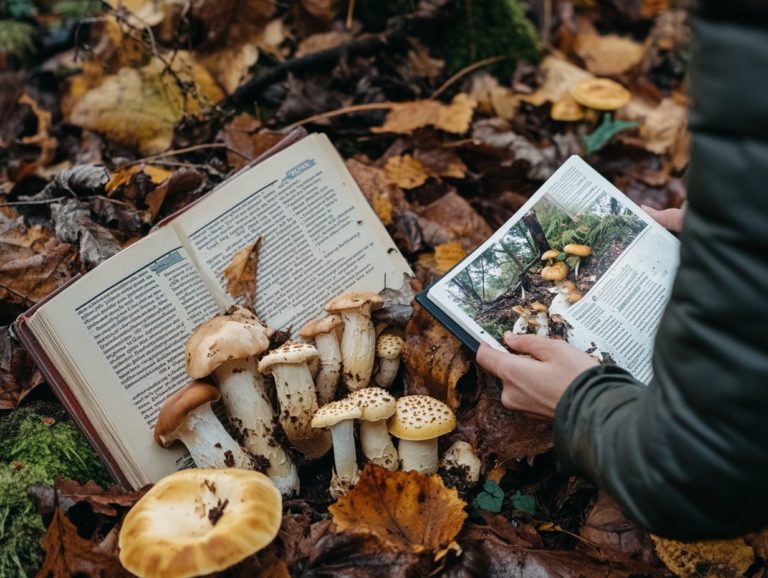What Edibles Can Be Found in Coastal Areas?
Coastal areas brim with a captivating array of edible plants and seafood, including diverse marine life and salt-tolerant species. This presents a delightful bounty for those who venture to forage.
From the vibrant flora adorning the sandy shores to the diverse marine life waiting to be discovered, this guide is your gateway to exploring common types of edible plants and fresh fruits you may encounter along the coast. You will also learn about the nutrition benefits they offer.
Valuable insights into safe gathering practices for seafood are also included. You will find essential precautions to help you identify potentially harmful species and wildlife. Additionally, sustainable foraging methods are designed to preserve our precious ecosystems.
Prepare for an exciting culinary adventure at the coast, where the salty wind carries the promise of delicious coastal edibles!
Contents
Key Takeaways:

- Coastal areas are rich in edible plants and seafood, offering a diverse foraging experience.
- Identify and avoid potentially harmful plants or animals when foraging.
- Follow responsible practices to protect the environment for future generations.
Overview of Foraging in Coastal Areas
Foraging means searching for and gathering wild food. In coastal areas, this presents a remarkable opportunity to immerse yourself in the rich biodiversity of native edible plants and seafood flourishing in these sandy environments. This practice reestablishes your connection to the land and aids in restoring natural habitats by promoting sustainable techniques while enhancing biodiversity.
With the salty breeze and diverse flora and fauna surrounding you, coastal ecosystems are brimming with resources that can enrich your nutrition while preserving our natural heritage.
As you explore tidal pools for mollusks soft-bodied animals like clams or oysters or gather seaweed along the shore, you ll gain firsthand insight into the fragile balance of coastal ecology. Engaging in foraging can also deepen your connections with fellow community members, fostering a culture of education and shared recipes. Local foragers often share their insights and the significance of particular native species. These interactions foster stronger communal bonds and raise awareness about the importance of ecological conservation.
Embracing sustainable foraging practices is vital for coastal restoration. This ensures that species populations thrive while reducing your impact on the environment. In doing so, you not only benefit the landscape but also become a steward of its well-being and advocate for sustainable practices in your community.
Edible Plants and Fruits in Coastal Areas
Coastal areas harbor an impressive array of edible plants and fruits essential to local diets and ecosystems. These native species, from coastal wild edibles like Sea Rocket to nutrient-rich herbs such as Samphire, enrich culinary diversity and play a crucial role in preserving local biodiversity and supporting community food sources.
Embracing these treasures can transform your dining experience while nurturing the environment.
Common Types and Nutritional Benefits
Consider the delightful world of edible coastal plants, like American beachgrass (Ammophila breviligulata) and Cattail. These treasures not only tantalize your taste buds with unique flavors but also offer significant nutritional value.
Rich in vitamins and minerals, these native species are vital components of a balanced diet. They allow you to embrace local biodiversity while maximizing your health.
Take American beachgrass, for instance. Its high fiber content makes it an excellent choice for promoting digestive health. You can easily harvest the young shoots and toss them into salads or stews, adding a subtle, nutty flavor that elevates your dishes.
Then there’s Cattail, often thriving in wetlands and along the shores of coastal ecosystems. With its edible stalks and roots, this plant serves as a rich source of carbohydrates that can be ground into flour. Plus, its anti-inflammatory properties can help reduce inflammation, making it a valuable ally in traditional herbal medicine.
Incorporating these coastal plants into your cooking not only boosts your nutrition but also fosters community connections through a shared appreciation of local food sources.
Edible Seafood in Coastal Areas

The coastal waters are a veritable treasure trove of edible seafood. They offer a rich diversity of species that significantly enhance local diets and bolster economies.
From the vibrant array of fish to the delicate allure of shellfish, these marine resources serve vital nutritional components and play a pivotal role in sustaining ecological balance.
They also encourage community engagement in sustainable fishing practices, ensuring that both the environment and local traditions thrive harmoniously.
Types of Seafood and How to Safely Gather Them
When you explore the types of seafood available along coastal areas, understanding safe gathering methods is essential for your health and the environment’s sustainability.
From clams to seaweed, mastering proper techniques and seasonal guidelines ensures that you can indulge in these marine delicacies while minimizing ecological impact.
Foraging opens up a unique avenue to engage with local ecosystems and communities. It promotes education about biodiversity and sustainable practices.
As a novice forager, you might begin with easily recognizable species like mussels and crabs. Be sure to collect them during open seasons to avoid overharvesting.
Many communities offer educational workshops that emphasize sustainable practices, such as using a digging fork instead of your bare hands to gently extract clams. Being aware of tidal patterns and environmental regulations that differ by region is crucial.
By gathering responsibly, you not only relish the ocean’s offerings but also play a vital role in preserving its ongoing vitality and the ecosystem’s delicate balance.
Precautions to Take When Foraging in Coastal Areas
Foraging in coastal areas demands a sharp awareness of the necessary precautions to ensure both your safety and the preservation of the environment.
- Identify poisonous species.
- Learn to recognize safe habitats.
This knowledge safeguards your health and fosters responsible foraging practices within the community. It promotes a culture of respect for nature s offerings.
Identifying and Avoiding Poisonous Plants and Animals
Identifying and avoiding poisonous plants and animals is crucial for foragers along coastal areas. Some species can seriously impact your health.
Familiarizing yourself with local flora and fauna, including poisonous plants that can make you sick, is essential for safe foraging adventures.
Coastal environments are home to many organisms. Among them are several species, including toxic plants and wildlife, that pose significant risks. Take poison ivy, for example; its recognizable leaves can lead to severe skin irritation. Then there are sea anemones and certain types of jellyfish that can deliver painful stings.
Know the signs of dangerous species. Look for their distinctive leaf shapes, colors, and preferred habitats. You ll find plenty of educational resources available, including local guides and mobile applications that offer identification help and precautions for avoiding these dangerous plants and animals. This knowledge not only safeguards your health but also enriches your overall experience as you enjoy nature s bounty.
Sustainable Foraging Practices

Embracing sustainable foraging practices is vital to keep our coastal ecosystems thriving! This ensures that future generations can likewise revel in the abundant diversity of edible plants and seafood.
By nurturing responsible harvesting techniques and cultivating community awareness, you can play a pivotal role in preserving and restoring local habitats while enjoying the rewards that biodiversity offers.
Tips for Responsible Foraging and Protecting the Environment
To practice responsible foraging while safeguarding the environment, follow several key tips to ensure minimal impact on local ecosystems. Engage with community education initiatives and adhere to seasonal harvesting guidelines to help sustain biodiversity in coastal areas.
Familiarizing yourself with local regulations and actively participating in workshops that teach sustainable harvesting techniques is highly encouraged. Joining local foraging groups can enhance your understanding of plant and animal populations and foster a sense of stewardship among fellow participants.
Utilizing mobile applications for plant identification helps avoid overharvesting vulnerable species. By sharing knowledge within your community, you can collectively promote practices that protect your natural surroundings and enhance local education while enjoying the substantial bounty nature offers.
Frequently Asked Questions
What Edibles Can Be Found in Coastal Areas?
Many edible plants and animals can be found in coastal areas, including seaweed, mussels, clams, and various types of fish. If you’re curious about local options, check out what types of edibles grow in my area.
Can I Eat Seaweed from Coastal Areas?

Absolutely! But first, make sure you ve identified it correctly. Ensure the type of seaweed is safe for consumption.
Are There Any Shellfish That Can Be Harvested in Coastal Areas?
Yes, several types of shellfish can be harvested in coastal areas, such as mussels and clams. However, check for any local regulations or restrictions before harvesting.
What Types of Fish Can Be Caught in Coastal Areas?
A variety of fish can be caught in coastal areas, including salmon, cod, halibut, and more. Again, check for any regulations or restrictions before fishing.
Can I Forage for Berries in Coastal Areas?
Yes! Many types of berries can be foraged in coastal areas, such as salmonberries, huckleberries, and blackberries. Just be sure to properly identify the berries before consuming them.
Is It Safe to Eat Edibles from Coastal Areas?
As with any foraging, it s important to properly identify and ensure the safety of the edibles found in coastal areas. It s also recommended to check for any local advisories or restrictions before consuming them.






